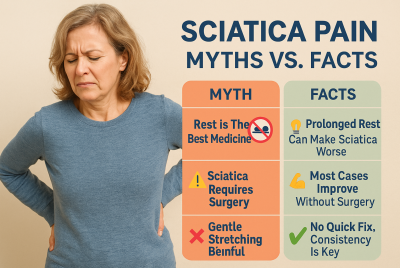How To Tell The Difference Between Sciatica And Hamstring Pain
Discover how to tell the difference between sciatica and hamstring pain. Learn valuable insights and find relief with our expert guide. Ever found yourself wondering why the back of your leg is causing you such grief? Is it a sharp pain extending from your lower back to your foot? Or does it feel like a muscle pull after a strenuous workout? As someone who has studied it extensively, I can better help you understand these pains.
What Is Sciatica?
Sciatica isn’t a medical condition in itself but a symptom of an underlying issue. Generally, it’s caused by irritation or compression of your sciatic nerve. This nerve is the longest in your body, running from your lower back through your hips and buttocks down to each leg.
Causes Of Sciatica
The most common culprit for sciatica is a herniated disc in your spine. Sometimes, other conditions like spinal stenosis, spondylolisthesis, or even a tumor can also lead to sciatica pain.
Symptoms Of Sciatica
Now, what does sciatica feel like? It’s often described as a shooting, burning pain on one side that travels from your lower back down to your leg, knee and feet. The pain can range from mild to severe, and it may be accompanied by numbness or tingling sensations.
How Do I Know If I Have Sciatica Or Muscle Pain?
Identifying whether you have sciatica or muscle pain requires attention to symptoms. Sciatica usually starts in the lower back or buttock, then radiates down the leg, possibly reaching the foot. It can present as a sharp, burning sensation, numbness, or tingling. Prolonged sitting might worsen it. Muscle pain, on the other hand, often feels like a localized ache or tightness. It might be tender to the touch and become more painful during or after physical activity. The pain doesn’t typically radiate like sciatica. Although both cause discomfort, their symptoms are distinct. For a definitive diagnosis, consult a healthcare professional.
What Is Hamstring Pain?
Hamstring pain, on the other hand, is generally muscle-related. Your hamstrings are the group of three muscles located at the back of your thigh. When you overstretch or strain these muscles, you end up with what we call a hamstring injury.
Causes Of Hamstring Pain
A sudden sprint or a poorly executed stretch – activities that put too much load or pressure on your hamstrings can cause this kind of pain. It’s common among athletes and those who are very physically active.
Symptoms Of Hamstring Pain
Typically, you might experience a sudden, sharp pain in the back of your thigh. You might even hear a “pop” during the injury. This might be followed by swelling, tenderness, and bruising.
Can Tight Hamstrings Feel Like Sciatica?
Tight hamstrings can mimic some symptoms of sciatica. When hamstrings tighten, they create discomfort in the back of the thigh. This can sometimes be confused with sciatic pain, which originates from the lower back or buttock and travels down the leg. However, sciatica often presents as a burning, tingling, or numbing sensation, possibly extending to the foot. Tight hamstrings usually produce localized pain or tightness, mainly when stretching or engaging the muscles. They don’t typically produce the radiating pain characteristic of sciatica. Observing the specific nature and location of pain can help differentiate between the two. Always consult a professional for an accurate diagnosis.
Hamstring Tightness
Hamstring tightness refers to the sensation of tension or stiffness in the muscles at the back of the thigh. It can result from various factors, including muscle imbalances, overuse, inadequate stretching, or a sedentary lifestyle. Hamstring tightness may limit flexibility and increase the risk of injuries, such as strains or pulls. To alleviate tightness, regular stretching exercises targeting the hamstring muscles are recommended. Incorporating dynamic warm-up exercises, like leg swings or high knees, can also help loosen the muscles. Additionally, maintaining proper posture and avoiding prolonged sitting can prevent further tightening. If persistent or accompanied by severe pain, it is advisable to consult a healthcare professional for a thorough evaluation and appropriate treatment.
Hamstring Sciatic Nerve Entrapment
Hamstring sciatic nerve entrapment occurs when the sciatic nerve gets compressed within the hamstring muscles. This compression can lead to pain, tingling, and numbness in the affected leg. To diagnose it, doctors might use nerve conduction studies. For relief, stretching the hamstring muscles, applying heat, and undergoing physical therapy can help. Persistent cases might require medical intervention. Always consult a healthcare professional for a precise diagnosis and treatment plan.
Hamstring Sciatica Stretch
Hamstring sciatica stretches can help alleviate pain caused by nerve compression. Here’s a simple stretch:
- Lie on your back with your legs extended.
- Lift your affected leg, keeping it straight.
- Grasp behind the thigh with both hands.
- Gently pull the leg towards your chest until you feel a stretch.
- Hold for 20-30 seconds, then release.
- Repeat 3 times.
- Switch legs if needed.
Remember to stretch slowly, avoiding any sharp pain. Consult a therapist for more stretches.
Hamstring Pain For Months
Persistent hamstring pain lasting for months requires attention. Causes might include strains, overuse, or scar tissue formation. Resting the affected leg, applying ice to reduce swelling, and using compression to support the muscle is crucial. Engage in gentle stretching and strengthening exercises to promote healing. Avoid activities that aggravate the pain. Non-prescription pain relievers can help manage discomfort. If pain persists, seek medical evaluation.
Distinguishing Sciatica From Hamstring Pain
Location Of Pain
Sciatica usually extends from the lower back to the foot, while hamstring pain is localized in the back of the thigh.
Nature And Duration Of Pain
The pain from sciatica often feels burning or electric and lasts for weeks. Hamstring pain, however, often comes on suddenly and can improve over days to weeks with rest.
Accompanying Symptoms
Sciatica might also cause numbness or tingling, while hamstring pain often comes with swelling or bruising.
How Do I Know If I Have Sciatic Nerve Or Hamstring?
Distinguishing between sciatic nerve pain and hamstring issues is essential. Sciatic pain often originates in the lower back or buttock and shoots down the leg, possibly reaching the foot. It can feel like a sharp, burning sensation, numbness, or tingling. Sitting or standing for long periods might aggravate it. Hamstring issues typically cause pain at the back of the thigh. This pain intensifies when bending over or straightening the leg. Muscle tightness and tenderness are common symptoms. While both can cause discomfort, their origins and characteristics differ. If uncertain, consulting a healthcare professional can provide a proper diagnosis.
How Do You Relieve Sciatic Pain In Your Hamstring
Relieving sciatic pain in the hamstring involves several strategies:
- Stretch Gently: Begin with mild hamstring stretches, holding each stretch for 20-30 seconds.
- Apply Heat: Warm compresses can relax tight muscles and improve blood flow.
- Maintain Good Posture: Proper alignment can alleviate pressure on the sciatic nerve.
- Take Over-The-Counter Pain Relievers: Non-prescription NSAIDs, like ibuprofen, can reduce inflammation and pain.
- Engage In Regular Exercise: Low-impact activities like walking or swimming can help.
- Try Physical Therapy: A therapist can provide tailored exercises and stretches.
- Use Massage Therapy: Targeted massages can release tension and improve flexibility.
If pain persists, consult a healthcare professional.
Medical Examinations For Accurate Diagnosis
How to tell the difference between sciatica and hamstring pain? If you’re still unsure, a doctor can help confirm your situation. They might perform a straight leg raise test to check for sciatica or a physical examination to assess for a hamstring injury. Further imaging tests like MRI or ultrasound might be necessary in some cases.
Management Of Sciatica And Hamstring Pain

So, you’ve identified your pain – what now? Let me share some suggestions based on my experience and understanding.
Therapies And Exercises
For both conditions, physical therapy exercises can be beneficial. For sciatica, try stretching and strengthening exercises for your lower back. Initially, rest, ice, and elevation are the key to hamstring pain. Once healing has started, gently stretching and strengthening the hamstring can help.
Exercise can significantly help manage both sciatica and hamstring pain.
For Sciatica – Exercises primarily aim to strengthen the back and core muscles, improve flexibility, and promote proper posture. Here are some examples:
- Stretching Exercises: Stretching the lower back, buttocks, and legs can help reduce the pressure on the sciatic nerve and alleviate pain. Some stretch to consider include the knee-to-chest stretch and the seated spinal stretch.
- Strengthening Exercises: Strengthening the muscles that support the spine, including the abs and back muscles, can help reduce sciatica symptoms. Planks are an excellent exercise for this purpose.
- Aerobic Exercises: Low-impact aerobic activities like walking or swimming can help improve overall fitness and endurance. This, in turn, can reduce sciatica symptoms.
For Hamstring Pain – Exercises aim to strengthen and stretch the hamstring muscles and the muscles surrounding the hip and knee joints. However, these should only be done once the acute pain has subsided.
Here are some examples:
- Stretching Exercises: Gentle stretches can help improve flexibility in the hamstring muscles. One example is the hamstring stretch, where you sit on the floor with one leg extended and try to reach your toes.
- Strengthening Exercises: As your pain improves, strengthening exercises can help rehabilitate the muscle and prevent future injuries. Hamstring curls and bridges are two examples of exercises that can help strengthen these muscles.
Before starting any new exercise regimen, consult a healthcare professional or physical therapist to ensure the activities are safe and suitable for your condition.
Lifestyle Modifications
Maintaining a healthy lifestyle goes a long way, guys. Regular exercise, good posture, and a healthy diet – they all help keep these issues at bay. For sciatica, consider ergonomic furniture if you’re sitting for long hours.
Hamstring Strain Recovery Time
The recovery time for a hamstring strain depends on the severity of the injury. Mild strains may take a few weeks to heal, while more severe strains could require several months of rehabilitation. Initially, rest, ice, compression, and elevation (RICE) are recommended to reduce pain and inflammation. Physical therapy exercises like stretching are crucial for healing and preventing future injuries. The recovery duration also depends on individual factors like age, overall health, and adherence to the rehabilitation program. Consulting a healthcare professional for an accurate diagnosis and personalized recovery plan is essential. Patience, consistency, and proper rehabilitation techniques are critical to successfully recovering from a hamstring strain.
Seeking Medical Advice
If you’re experiencing sciatica or hamstring pain, it is advisable to seek medical advice promptly. Sciatica refers to pain that radiates along the path of the sciatic nerve, usually caused by compression or irritation. Hamstring pain can result from strains, tears, or overuse of the muscles at the back of the thigh. Consulting a healthcare professional, such as a doctor or physiotherapist, can help determine the underlying cause of your symptoms and provide appropriate treatment options. They may recommend a combination of rest, physical therapy, pain management techniques, and possibly imaging or further diagnostic tests to guide your recovery.
Frequently Asked Questions (FAQs)
1. Can sciatica pain be mistaken for a hamstring injury?
Yes, since both conditions affect the back of the leg and cause similar pain, they can be easily confused.
2. What is the fastest way to relieve sciatic nerve pain?
While it depends on the underlying cause, regular stretching, maintaining good posture, and over-the-counter pain relievers can help manage sciatica symptoms.
3. How long does hamstring pain last?
Minor hamstring injuries can heal within a few days with proper rest and care. However, more severe injuries can take several weeks or even months.
4. Can I exercise with sciatica or hamstring pain?
Yes, but the type and intensity of exercise should be adjusted based on your comfort level and doctor’s advice. Low-impact activities like swimming can be beneficial.
5. Should I use heat or ice for hamstring pain?
Initially, icing can help reduce swelling and pain. After a few days, heat can be used to relax the muscles and promote healing.
Extra FAQs Related To How To Tell The Difference Between Sciatica And Hamstring Pain
6. How to tell the sciatica hamstring pain symptoms?
To identify sciatica hamstring pain symptoms, note radiating pain from the lower back to the leg, tingling, numbness, and muscle weakness. Hamstring issues typically present localized pain in the thigh. Distinct characteristics help differentiate. Consult a professional for clarity.
7. How to tell the difference between sciatica and hamstring pain?
Differentiating between sciatica and hamstring pain involves identifying the source and location of the discomfort. Sciatica originates in the lower back and radiates down the leg, while hamstring pain is typically localized to the back of the thigh. Consulting a healthcare professional for accurate diagnosis is recommended.
8. Why Is My Hamstring Pain When Sitting?
Hamstring pain when sitting can arise from tight muscles, prolonged sitting, or sciatic nerve compression. Inactivity or poor posture exacerbates the discomfort. Regular stretching and proper ergonomics can alleviate the pain. If persistent, consult a healthcare professional.
9. Why did I feel posterior thigh pain from sitting?
Posterior thigh pain from sitting can result from prolonged pressure on the sciatic nerve, tight hamstrings, poor posture, or muscle fatigue. Regular movement and proper seating ergonomics can help mitigate discomfort. Seek guidance if pain persists.
10. What are pinched nerve hamstring symptoms?
Pinched nerve hamstring symptoms include sharp pain in the thigh, tingling, numbness, muscle weakness, and discomfort when moving the leg. These symptoms might radiate and vary in intensity. Accurate diagnosis by a professional is essential for proper treatment.
Understanding Sciatica And Hamstring Pain – Conclusion
In conclusion, To tell the difference between sciatica and hamstring pain requires careful evaluation of symptoms and an understanding of their distinct characteristics. Sciatica typically originates from the lower back and radiates down the leg, often accompanied by tingling, numbness, or weakness. On the other hand, hamstring pain is localized to the back of the thigh and can be aggravated by activities involving bending or stretching the leg. Seeking medical advice and diagnosis from a healthcare professional is crucial for accurate identification and appropriate treatment. Diagnostic tests, such as physical examinations, imaging studies, or nerve conduction tests, may be recommended to confirm the underlying cause. Prompt and accurate diagnosis is essential for effective management and relief from the specific condition causing the pain.
Remember, while sciatica and hamstring pain can be pretty uncomfortable, they’re also manageable. It’s all about understanding the nuances and responding accordingly. So, pay attention to your body, and don’t hesitate to seek medical help if the pain persists or intensifies.
Disclaimer
Please note that this article should not replace professional medical advice. Consult a healthcare professional for an accurate diagnosis and tailored treatment plan.
👉 Explore more:




